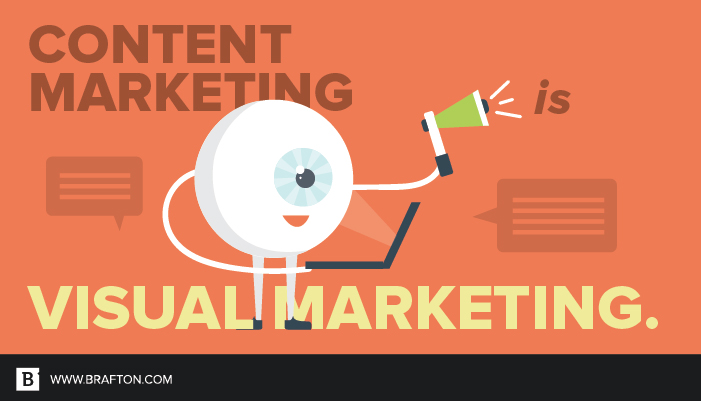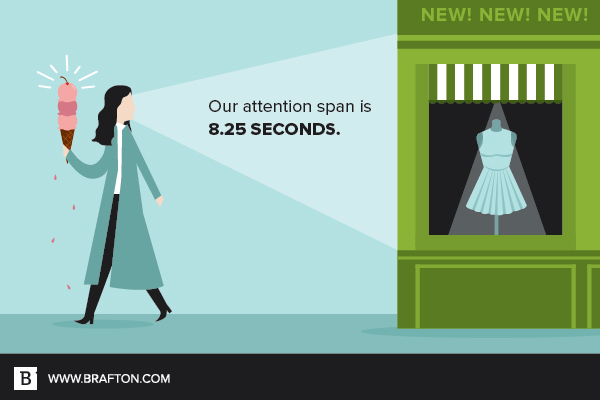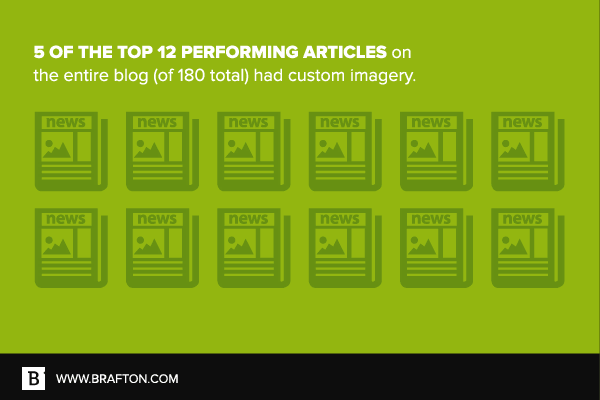Editor’s note: Updated August 2019.
Visual marketing adds new dimension to your content marketing. While your competitors are still learning to fly with long-form blog posts and maybe a few gated assets, your content strategy should be centered on dynamic media like video, graphics and custom illustration.
In 2019, content marketing is visual marketing. There’s no way around it.
So if you’re planning the remainder of the year’s marketing campaign, know that the only way to truly meet your target audience’s demand for relevant, authoritative information is to meet them on their terms. Provide them with visually arresting, must-see content that hits the brain in all the right places.
What is visual marketing?
Visual marketing is the connection between a visual, like an image or video, and the idea it conveys. Based on cognitive psychology, companies can effectively market their products and services through a visual medium. This makes information much easier for consumers to retain and process.
So much easier that 90% of the information transmitted to the brain is visual.
And the brain can process these visuals 60,000 times faster than text.
Because vision is such a dominant sense, it’s inherently obvious that marketers should be upping their investments to capitalize on optical content.
Our eyes absorb content at volumes that are unprecedented compared with previous generations of consumers. You should be helping them wade through what matters and what doesn’t.

Visuals afford a number of physiological advantages over other content types, such as:
- Clarifying ideas and abstract concepts.
- Supporting the understanding of new ideas.
- Weeding out incorrect information.
Visual marketing goals
Humans are visual learners.
Go to any grade-school classroom today and you see tablets, interactive games and colorful presentations. Gone are the days of stale lectures and barely visible chalk on a grainy challkboard.
A digital marketing target audience needs quick, frictionless information – straight to inboxes, social feeds and web search results pages. Visual assets make this possible.
They require less buy-in than a text-heavy blog post or lengthy white paper. Plus, visuals accomplish numerous marketing goals, like:
Brand awareness and identity
Visual branding is a first impression, often the only impression a consumer or buyer will ever have of your brand.
In other words, you have to get it right.
Company logos, color contrasts and typography create a larger picture of what your brand stands for and why an audience needs to sit up and pay attention to what you have to say. Having a consistent visual presence across all online channels ensures you’re creating a cohesive experience for users throughout every stage of the marketing funnel.
Product or service demonstration
What you sell matters. How you sell it matters even more.
Whether it’s a 90-second web demo or an in-depth, in-person product tutorial, you need a visual, interactive component to your brand.
There’s only so much a written explanation or FAQ can accomplish. But a comprehensive video that details important elements of your product or service is mandatory.
Content scannability
Visual marketing doesn’t mean you throw your written content out the window. There’s still plenty of room in your marketing campaign for the old-fashioned written word since text is the primary way search engines crawl and index your web pages.
That said, your content needs to be optimized for a mobile-first audience with a short attention span.
In practice this means using html subheads and imagery to break up text every 200 or 300 words. By embedding visuals throughout your on-page content you create a more satisfying, multimedia user experience.

At a very basic level, readers of any demographic prefer content that is easy to consume versus a laborious, long read.
Social media shareability
Content that is scannable tends to also be more shareable across social media platforms.
With roughly one-third of the planet being on social media, it’s absolutely imperative that content perform not just for organic search engines but for human users too.
If it doesn’t get shared, it hardly exists.

Facebook and Twitter posts that contain images receive 70% and 78% more shares, respectively, than those with just text. And platforms like Instagram and Snapchat put visuals front and center, making text a secondary factor in social performance.
Lead generation and sales enablement
It’s estimated that 90% of all snap purchases are based on the branding of a product, aka how it looks and the emotion it conjures.
This means visual content marketing isn’t just about being present or being seen; it’s about driving sales too.

Videos and imagery play on humans’ conscious and unconscious biases in a way that text does not. They are deeply rooted mediums that our brains are hardwired to absorb and enjoy.
And that’s a powerful fact that can be employed in lead gen campaigns. Moving prospects further down the funnel via visuals brings them one step closer to becoming a customer, completing the overarching goal of all marketing and advertising.
How to go visual
Including visual elements in your content marketing strategy is easy.
Below are a number of assets to consider and how to quickly integrate them into your marketing campaigns:
Infographics
Design-centric formats are ideal for social media and email campaigns.
Infographics in particular combine the best in editorial and graphics to visualize key data points, important concepts and industry trends.
Sure, you could talk at length about rising economic spend in your sector, but a simple infographic with rising arrows and on-brand illustrations is going to make your point much more clearly.
It’s about simplifying content down to its bare messaging.

Videos
Video marketing is on the upswing, and has been for the better part of the last five years. Although it tends to require talent and budget a lot of organizations don’t have, video is the cornerstone of human connection.
Finding a way to incorporate it – in some form – in your marketing is table stakes in 2019 and beyond. Luckily, there are numerous formats and budgetary options to work with, such as:
- GIFs.
- Animations.
- Web demos.
- Live footage/livestreams.
- Augmented/virtual reality.
- On-location shoots.
- Corporate testimonials.
- Webinars.

Formatted eBooks, white papers and case studies
One of the best ways to immediately make your marketing more visual is to convert existing assets to new formats.
Take a blog post and turn it into an eBook complete with branded elements and illustrative cues.
You can also make your content more authoritative and clickworthy by supporting your research with pull quotes, page breaks, logos, photography, corporate branding and visual markers.
Three-thousand words on a new industry trend is a lot more digestible when complemented by data visualizations, text callouts and graphical overlays.
When in doubt, think like a reader. What bores you to tears, and what actually keeps your interest?

User-generated content
Sometimes you don’t even have to do the legwork in your marketing. Let your audience do it for you.
By running branded hashtag campaigns, social media contests and product giveaways you can gin up interest and engagement in your company’s marketing efforts. Then you can compile all of these interactions into something visually compelling.
Take Bitter Pops, for instance.
They’re a small-time brew shoppe in Chicago and they run an Instagram account called “Bitter Pups.” Followers show up in store with their furry friends and take photos with Bitter Pops swag to be featured online. We loved this idea so much we crowned it one of our favorite social media campaigns in recent memory.
Rather than running the same types of social media posts over and over, allow your followers to post for you.
Over time, followers act on their own accord simply to be part of something bigger than themselves.
That’s free, visual content for you.
Blog posts
As we stated before, blog posts can be visual too.
This post, for example, is quite visual, as we included several forms of content to better illustrate our point. We featured social media embeds, YouTube videos, graphical CTAs to in-depth content, custom images and GIFs.
It’s basically blogging 2.0.
Just because the text is doing most of the messaging, you still need your blogs to be attention-grabbing, which is where visuals come in.
Paid ads
Paid ads are another content format to consider.
Because Google Ads Quality Scores account for the quality, creativity and relevance of your ad landing pages, your ads need to be optimized with visual components.
This often means on-brand colors, thematic imagery or photographs and clickable CTA buttons to best convert users who land on your page.
Depending on where you’re sending users, you may need conversion forms, video demos or product comparisons on your landing page, too.
In this case, visuals once again work best. Keep your text to a minimum and let your product branding speak for itself. This goes for ads across search, social media and display networks.
But avoid stock photography
Stock images are the downfall of online humanity. They’re so obviously staged and hilariously boring that they can actually have a negative impact on your brand.

So avoid stock photography if possible. Hi-res photos, in general, have value in some cases, but if you have the opportunity to custom-create design assets, then do so.
Visualize your success
Visual marketing is now mainstream across B2C and B2B organizations, though it may still have ground to make up in your specific industry.
Some companies still rely on physical marketing like trade shows and business cards – more power to them. Others have pivoted fully into automated technology and digital-only marketing – even more power (and ROI) to them.
While you may not be able to convince higher-ups to move the majority of your marketing budget to visual, you should at least aim to outpace your competitors’ visual output.
Videos (63%) are already shared on social media more often than blogs (60%). And 51% of B2B marketers are making visual assets their top priority moving forward. So clearly there is momentum toward going visual.
Will you ride the wave or sit it out?





